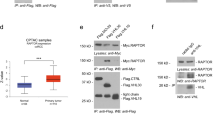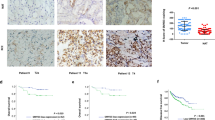Abstract
The von Hippel–Lindau (VHL) tumor suppressor protein is the substrate binding subunit of the CBCVHL E3 ubiquitin ligase complex. Mutations in the VHL gene cause a variety of tumors with complex genotype/phenotype correlations. Type 2A and type 2B VHL disease are characterized by a low or high risk of renal cell carcinoma, respectively. To investigate the molecular basis underlying the difference between disease types 2A and 2B, we performed a detailed biochemical analysis of the two most frequent type 2A mutations, Y98 H and Y112 H, in comparison to type 2B mutations in the same residues, Y98N and Y112N. While none of these mutations affected the assembly of CBCVHL complexes, the type 2A mutant proteins exhibited higher stabilities at physiological temperature. Moreover, the type 2A mutant proteins possessed higher binding affinities for the key cellular substrate, hypoxia-inducible transcription factor 1 (HIF-1α). Consistent with these results, type 2A but not type 2B mutant VHL proteins retained significant ubiquitin ligase activity towards HIF-1α in vitro. We propose that this residual ubiquitin ligase activity is sufficient to suppress renal cell carcinogenesis in vivo.
This is a preview of subscription content, access via your institution
Access options
Subscribe to this journal
Receive 50 print issues and online access
$259.00 per year
only $5.18 per issue
Buy this article
- Purchase on Springer Link
- Instant access to full article PDF
Prices may be subject to local taxes which are calculated during checkout





Similar content being viewed by others
References
Allen DL, Pielak GJ . (1998). Protein Sci 7: 1262–1263.
Bradley JF, Collins DL, Schimke RN, Parrott HN, Rothberg PG . (1999). Am J Med Genet 87: 163–167.
Brauch H, Kishida T, Glavac D, Chen F, Pausch F, Hofler H et al (1995). Hum Genet 95: 551–556.
Bruick RK, McKnight SL . (2001). Science 294: 1337–1340.
Buchberger A, Gassier CS, Buttner M, McMacken R, Bukau B . (1999). J Biol Chem 274: 38017–38026.
Chen F, Kishida T, Yao M, Hustad T, Glavac D, Dean M et al (1995). Hum Mutat 5: 66–75.
Chen F, Slife L, Kishida T, Mulvihill J, Tisherman SE, Zbar B . (1996). J Med Genet 33: 716–717.
Clarke J, Fersht AR . (1993). Biochemistry 32: 4322–4329.
Clifford SC, Cockman ME, Smallwood AC, Mole DR, Woodward ER, Maxwell PH et al (2001). Hum Mol Genet 10: 1029–1038.
Cockman ME, Masson N, Mole DR, Jaakkola P, Chang GW, Clifford SC et al (2000). J Biol Chem 275: 25733–25741.
Epstein AC, Gleadle JM, McNeill LA, Hewitson KS, O'Rourke J, Mole DR et al (2001). Cell 107: 43–54.
Feldman DE, Spiess C, Howard DE, Frydman J . (2003). Mol Cell 12: 1213–1224.
Feldman DE, Thulasiraman V, Ferreyra RG, Frydman J . (1999). Mol Cell 4: 1051–1061.
Gnarra JR, Tory K, Weng Y, Schmidt L, Wei MH, Li H et al (1994). Nat Genet 7: 85–90.
Hansen WJ, Ohh M, Moslehi J, Kondo K, Kaelin WG, Welch WJ . (2002). Mol Cell Biol 22: 1947–1960.
Hergovich A, Lisztwan J, Barry R, Ballschmieter P, Krek W . (2003). Nat Cell Biol 5: 64–70.
Hoffman MA, Ohh M, Yang H, Klco JM, Ivan M, Kaelin Jr WG . (2001). Hum Mol Genet 10: 1019–1027.
Hon WC, Wilson MI, Harlos K, Claridge TD, Schofield CJ, Pugh CW et al (2002). Nature 417: 975–978.
Ivan M, Kondo K, Yang H, Kim W, Valiando J, Ohh M et al (2001). Science 292: 464–468.
Iwai K, Yamanaka K, Kamura T, Minato N, Conaway RC, Conaway JW et al (1999). Proc Natl Acad Sci USA 96: 12436–12441.
Jaakkola P, Mole DR, Tian YM, Wilson MI, Gielbert J, Gaskell SJ et al (2001). Science 292: 468–472.
Kamura T, Maenaka K, Kotoshiba S, Matsumoto M, Kohda D, Conaway RC et al (2004). Genes Dev 18: 3055–3065.
Killenberg-Jabs M, Kern G, Hubner G, Golbik R . (2002). Biophys Chem 96: 259–271.
Kondo K, Kim WY, Lechpammer M, Kaelin Jr WG . (2003). PLoS Biol 1: E83.
Kondo K, Klco J, Nakamura E, Lechpammer M, Kaelin Jr WG . (2002). Cancer Cell 1: 237–246.
Li Z, Wang D, Na X, Schoen SR, Messing EM, Wu G . (2003). EMBO J 22: 1857–1867.
Lisztwan J, Imbert G, Wirbelauer C, Gstaiger M, Krek W . (1999). Genes Dev 13: 1822–1833.
Lonser RR, Glenn GM, Walther M, Chew EY, Libutti SK, Linehan WM et al (2003). Lancet 361: 2059–2067.
Maher ER, Kaelin Jr WG . (1997). Medicine (Baltimore) 76: 381–391.
Maranchie JK, Vasselli JR, Riss J, Bonifacino JS, Linehan WM, Klausner RD . (2002). Cancer Cell 1: 247–255.
Masson N, Willam C, Maxwell PH, Pugh CW, Ratcliffe PJ . (2001). EMBO J 20: 5197–5206.
Maxwell PH, Wiesener MS, Chang GW, Clifford SC, Vaux EC, Cockman ME et al (1999). Nature 399: 271–275.
Min JH, Yang H, Ivan M, Gertler E, Kaelin Jr WG, Pavletich NP . (2002). Science 296: 1886–1889.
Ohh M, Park CW, Ivan M, Hoffman MA, Kim TY, Huang LE et al (2000). Nat Cell Biol 2: 423–427.
Ohh M, Takagi Y, Aso T, Stebbins CE, Pavletich NP, Zbar B et al (1999). J Clin Invest 104: 1583–1591.
Ohh M, Yauch RL, Lonergan KM, Whaley JM, Stemmer-Rachamimov AO, Louis DN et al (1998). Mol Cell 1: 959–968.
Rathmell WK, Hickey MM, Bezman NA, Chmielecki CA, Carraway NC, Simon MC . (2004). Cancer Res 64: 8595–8603.
Reinstein J, Vetter IR, Schlichting I, Rosch P, Wittinghofer A, Goody RS . (1990). Biochemistry 29: 7440–7450.
Semenza GL . (1999). Ann Rev Cell Dev Biol 15: 551–578.
Stebbins CE, Kaelin Jr WG, Pavletich NP . (1999). Science 284: 455–461.
Wykoff CC, Sotiriou C, Cockman ME, Ratcliffe PJ, Maxwell P, Liu E, Harris AL . (2004). Br J Cancer 90: 1235–1243.
Acknowledgements
We thank Stefan Jentsch for continued support; Alan Fersht for generous hospitality and Chris Johnson for help with the stopped-flow experiments; Wilhelm Krek, Eamonn Maher, Nicola Pavletich, and Kazuhiro Sogawa for plasmids; Raymond Behrendt and Frank Freudenmann for help with the synthesis of Hyp-MIANS peptide; Stefan Müller and Olaf Stemmann for critical reading of the manuscript. This work was supported by Emmy Noether grant Bu 951/1-1 to /I-3 of the Deutsche Forschungsgemeinschaft (to AB) and European Molecular Biology Organization long-term fellowship ALTF-13 2002 (to PJ).
Author information
Authors and Affiliations
Corresponding author
Additional information
Supplementary Information accompanies the paper on Oncogene website (http://www.nature.com/onc)
Rights and permissions
About this article
Cite this article
Knauth, K., Bex, C., Jemth, P. et al. Renal cell carcinoma risk in type 2 von Hippel–Lindau disease correlates with defects in pVHL stability and HIF-1α interactions. Oncogene 25, 370–377 (2006). https://doi.org/10.1038/sj.onc.1209062
Received:
Accepted:
Published:
Issue Date:
DOI: https://doi.org/10.1038/sj.onc.1209062
Keywords
This article is cited by
-
Protein Expression of PI3K/AKT/mTOR Pathway Targets Validated by Gene Expression and its Correlation with Prognosis in Canine Mammary Cancer
Journal of Mammary Gland Biology and Neoplasia (2022)
-
VHL suppresses RAPTOR and inhibits mTORC1 signaling in clear cell renal cell carcinoma
Scientific Reports (2021)
-
Arginine refolds, stabilizes, and restores function of mutant pVHL proteins in animal model of the VHL cancer syndrome
Oncogene (2019)
-
The HIF and other quandaries in VHL disease
Oncogene (2018)
-
RSUME inhibits VHL and regulates its tumor suppressor function
Oncogene (2015)



